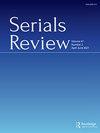Identifying Combinations of Altmetrics and Web of Science Usage That Linked to Early Citations of an Article Received: A Crisp-Set Qualitative Comparative Analysis (csQCA)
IF 0.9
4区 管理学
Q3 INFORMATION SCIENCE & LIBRARY SCIENCE
引用次数: 1
Abstract
Abstract The relations of altmetrics/usage of an article and its citations have been studied extensively by using several variable-oriented approaches, e.g., correlations analysis, regression analysis, and so on. Variable-oriented approaches are symmetrically designed to estimate the “net effects” of independent variables on outcomes. In contrast to variable-oriented approaches, Qualitative Comparative Analysis (QCA), a case-oriented approach based on set theory, models the concept of conjunctural causation, rather than a single net effect. QCA assumes asymmetry, equifinality, and causal complexity. In this study, based on four data sets from Scientific Reports, a Crisp-set Qualitative Comparative Analysis (csQCA) was employed to identify combinations of altmetrics and Web of Science usage (WOSusage) that linked to early citations an article received. Our results revealed the existence of diverse combinations of altmetrics and WOSusage that linked to early citations. The four combinations with the highest raw coverage for each data set indicated that high Mendeley readers together with high WOSusage played a key role in early citations an article received. The other altmetrics, including Twitter, Facebook, blogs, and news, played roles in linking to early citations an article received but varied in different combinations for each data set.确定Altmetrics和Web of Science用法与文章早期引用相关的组合:一个Crisp-Set定性比较分析(csQCA)
本文章由计算机程序翻译,如有差异,请以英文原文为准。
求助全文
约1分钟内获得全文
求助全文
来源期刊

Serials Review
INFORMATION SCIENCE & LIBRARY SCIENCE-
CiteScore
1.60
自引率
11.10%
发文量
49
期刊介绍:
Serials Review, issued quarterly, is a peer-reviewed scholarly journal for the international serials community. Articles focus on serials in the broadest sense of the term and cover all aspects of serials information; regular columns feature interviews, exchanges on controversial topics, book reviews, and conference reports. The journal encompasses practical, theoretical, and visionary ideas for librarians, publishers, vendors, and anyone interested in the changing nature of serials. Serials Review covers all aspects of serials management: format considerations, publishing models, statistical studies, collection analysis, collaborative efforts, reference and access issues, cataloging and acquisitions, people who have shaped the serials community, and topical bibliographic studies.
 求助内容:
求助内容: 应助结果提醒方式:
应助结果提醒方式:


